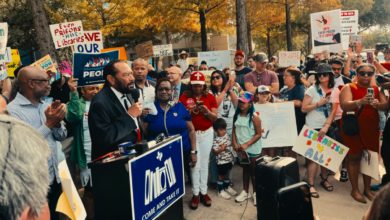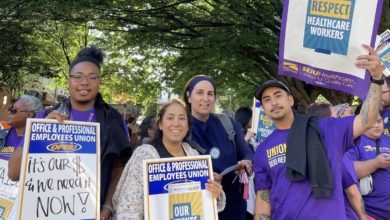It is at a moment of crisis that the nature of the existing social order is revealed. That which seems hidden in normal times is suddenly pushed to the fore.
For instance, it took Hurricane Katrina to reveal to the world the poverty, racism and national oppression suffered by the
|
Later, the blame game started. Was it officials from the city, state or federal government who were to blame for the shocking inattention to the needs of the poor, the elderly and the infirmed?
Of course, Bush and many FEMA officials are guilty of extreme negligence. So are officials on the local and state levels. They all are culpable. But that really isn’t the point. The current social and government system is not organized to meet human needs.
In Cuba, when a hurricane is approaching, every family and every individual knows the plan. Society is organized to make sure that no one falls through the cracks. Evacuation is planned for everyone. It is not that complicated, but it requires a government that is organized to take responsibility for all people.
In the United States, the government issues decrees and mandates, but it is organized primarily to meet the needs of corporations and commercial entities. The well-to-do manage to evacuate and the poor are left to climb onto the roof. The same syndrome reveals itself when it comes to health care, housing and education. There is no entity in a class-based private property system that is responsible to all.
The gruesome events at Virginia Tech have illuminated the utter incapacity of the current public healthcare system to deal with the issues of effective care for the mentally ill. It is a day-to-day problem that affects millions of people and their families, but appears hidden to the rest of society until a crisis exposes its utter ineffectiveness.
The acute mental health problems of the shooter, Cho Seung-Hui, were known by a large number of people. Like millions of other people in the United States, however, Cho was not connected to an adequate multi-layered system to provide help, support and ongoing treatment.
Such a system would require a major investment in resources for individuals, families and communities so that the complex issues of care and treatment could be addressed. If health care was oriented toward and funded to address human needs rather than maximizing profit for pharmaceuticals, hospital corporations and insurance companies this kind of integrated public healthcare system could be realized. But that is not the case today.
Cho’s situation is not isolated. Many other people in the United States, and in other countries, have displayed similar symptoms of illness and alienation leading to violence. Yet, the root cause and conditions are rarely discussed.
Absent from the media coverage
The killings at Virginia Tech are a terrible reminder of the defects in the current public healthcare system, especially in its inability to deal with chronic and acute mental illness. What everyone wants to know is—what can be done to prevent the recurrence of such tragic incidents?
On April 16, in just several hours, 33 people lay dead on the university’s campus. These were students and professors,
|
Much has been said over the past 10 days about the killing spree. The dominant voices have been capitalist media outlets, often casting the tragic events in a sensational light to increase viewers and raise ad revenue.
Particularly grotesque is the way nearly every bourgeois media outlet featured Cho’s photos and video manifesto, defending them as “newsworthy.” Never mind the rash of copycat threats popping up at other U.S. schools and in foreign countries.
Meanwhile, countless pundits and experts have tried to explain the cause of the killings to the U.S. public. The analyses have focused almost solely on the character and psychology of Cho.
Fueled by mental illness
It is clear that Cho was psychotic and delusional. He likely suffered mental impairment resulting from a biological psychiatric disorder. Some doctors believe that his psychosis may have worsened in recent years because of the social pressures of school and his surroundings.
Most agree that Cho was a textbook case of what has become known in the United States as a “school shooter”: an awkward, picked-on young man, a friendless figure, someone who had been bullied, someone bent on revenge, a careful planner.
His profile should not necessitate feverish calls from leftists and liberals for “more gun control” or unscientific condemnations of anti-depressant medication. However well-meaning, such analysis is misdirected and, ultimately, irresponsible.
Cho’s psychosis was evident well before the Virginia Tech shootings.
In December 2005, Cho was detained by campus police and held at a nearby private mental health facility for stalking two women students. He was judged to be an “imminent danger to self or others as a result of mental illness.”
He then was released with a recommendation to seek professional counseling. Neither the school nor the mental health facility ever followed up.
And Virginia Tech students complained to campus police about Cho’s disturbing writings on dormitory walls. Again, nothing was done.
To be sure, Cho’s psychosis was aggravated by his status as a Korean immigrant in the United States. Stories have surfaced about the racism and xenophobia he faced growing up in Virginia.
In middle and high school, Cho was picked on harshly for not being able to speak English well. When he did speak, students laughed at him and said things like, “Go back to China.”
Reviewing his mental state and personality traits after the fact helps to understand the illness behind the man directly
|
Taking these assessments at face value, however, the real question arises: Why is someone known to be mentally ill and dangerous “to self and others” left untreated and alone to face his illness?
The problem with U.S. health care
The capitalist system is organized to promote the supremacy of private property and the ownership of that property by a few rich capitalists. Society is geared toward generating profit, not attending to people’s needs.
This is true not only in the production of steel, automobiles, oil, clothing, housing and other well-known commodities. It also is true about the healthcare system. Illness is a source of profit. In fact, the system of healthcare delivery is set in motion not to heal the sick, but to generate profits for capitalists.
Social programs and benefits like comprehensive health care and mental treatment are not a source of high profit for the hospital corporations, giant pharmaceutical companies and the insurance companies. Investment goes where profit is greatest, not where societal need is greatest.
Under the current social and economic order, there is no community of people or sufficient state institutions organized to promote the welfare of people in general—certainly not those with mental illnesses. People cannot afford, or do not have access to, quality treatment that can enable them to lead a life that is productive—not only economically, but socially, politically, culturally and emotionally.
There are no adequate, affordable long-term care facilities for the ailing. It is why many people with mental illnesses end up homeless. It is why people like Cho have nowhere to turn.
And few attempts are made to correctly diagnose and treat mental illnesses—to do so is not “cost effective.” Ignoring a problem until it explodes is a cheaper and easier route to take. This is reality in the richest country in the world.
These gaps open the door to heinous crimes that are entirely preventable.
Had Cho received close monitoring and follow-up, possibly as an inpatient and subsequently as an outpatient the Virginia Tech tragedy may well have been averted. If this simple model were employed in the United States, biological disorders faced by many others like him could be contained, averting future atrocities.
Severely mentally ill people may be the least likely to come to the doctor or hospital. This problem is not only predicated on their illness, but also on a well-grounded fear that people may be treated badly by an impersonal system. Hundreds of thousands of people who suffer mental illness are locked up in prison. There are large incidences of mentally ill people being forced into solitary confinement.
The healthcare system needs to be stripped of its profit motive if patient care is to become the very top priority. Aggressive community-based, long-term follow-up care and treatment could be organized and funded so that such programs were truly comprehensive.
This would be sensible and humane. It would save innocent lives. But it will never happen unless there is a monumental struggle to reorganize health care on a completely socialist basis. To dislodge the capitalists who control and profit from health care poses the need for a revolutionary outcome.
A better way
People suffer mental illness under any social system. But the results are not the same when society is organized to
|
For example, in Cuba’s system of socialist distribution and planning, there is no large-scale private property and, thus, no insatiable, systematic drive for capitalist profits. Top priorities for Cuba’s revolutionary government are the top priorities of the people: health care, housing, education, jobs, safety and equality.
The Cuban constitution makes healthcare a right of every citizen and the responsibility of the government. The national health system is based on universal coverage and comprehensive care, with free preventive, curative and rehabilitation services.
Of course, Cuba’s health system is not problem-free. The 46-year-long economic blockade of Cuba prohibits or restricts the sale of medicines and medical equipment from the United States. Thus, Cuba is barred from purchasing nearly half of the world-class drugs on the market.
Even with the problems of underdevelopment in some areas, compounded by the blockade, Cuba’s people-first system has made strides that are recognized around the globe.
According to Britain’s Psychiatric Bulletin, “Mental health services are oriented not only toward the biomedical aspects of mental health, but also toward promotion of health, prevention of mental illness and, importantly, social rehabilitation.”
In Cuba, society is structured to empower the working class. The notion of communities is not abstract; it is very real.
All people, including those with mental illnesses like Cho Seung-Hui, are the responsibility of the community in which they live and to all of society as a whole. Mental health patients in Cuba are treated and then discharged into the community if it is considered to be safe. But it doesn’t end there. Discussions take place with members of the community, which collectively organizes follow-up and tries to provide assistance and prevent relapse.
This type of society, where the profit motive is replaced with socialist methods, is the only way to address mental health issues and help solve other social problems as well. Solving these problems in a practical way can prevent violent crimes committed by people with mental illnesses, while also increasing our humanity as a whole. Fighting for such a system is imperative.









